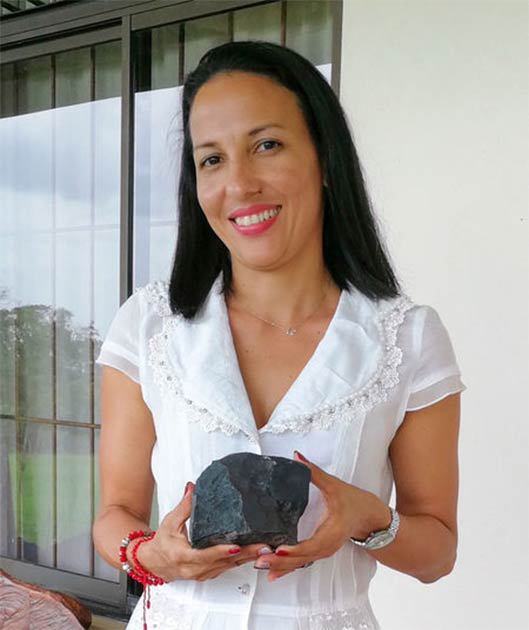Costa Rican Meteorite, Worth A Fortune, May Yield Life On Earth Clues
A Costa Rican meteorite may contain answers to the biggest questions of how life started on planet earth. Scientists at the Central American School of Geology are studying parts of a 2019 meteorite that impacted Aguas Zarcas, a village in Costa Rica’s tropical rainforest, described as being “more valuable than gold.” The Costa Rican meteorite could yield a cosmic library of new information about how life began on earth billions of years ago.
According to a 2017 paper by scientists at McMaster University and the Max Planck Institute, life on earth began between 3.7 and 4.5 billion years ago after a series of meteorites packed with essential chemical elements crashed into ponds of warm liquid. A series of wet and dry cycles then bonded together the basic molecular building blocks of life in these nutrient-rich ponds. And then miraculously our planet’s first self-replicating RNA molecules emerged, providing the first lines of genetic code that would ultimately evolve into all life on earth.

An unusual arrowhead-shaped meteorite from the Aguas Zarcas fall. This sample belongs to private collector, Michael Farmer. (Laurence Garvie / Center for Meteorite Studies, Arizona State University)
Cosmic Hot Rocks May Confirm Or Refute The Big Bang Theory
A Science Mag article states that on 23 April 2019, just after 9 pm, a “fiery emissary,” the so called Aguas Zarcas meteor, streaked across the skies of Costa Rica in a trail of unearthly orange and green light. This interstellar visitor was described as being the size of a washing machine. It fragmented as it passed through earth´s protective atmosphere and crashed into the jungle. This Costa Rican meteorite is composed of the same chemical elements that hit the earth´s crust just before life began billions of years ago.
Scientists collected a total of 60 pounds (27 kilograms) of meteorite fragments in Aguas Zarcas, the largest piece weighed about 4 pounds (1.8 kilograms). According to the researchers, the carbon within this meteorite was “formed from nuclear fission in stars and its origin.” And trapped within this “rock” were molecular fragments of water, nickel and sulfur, the same isotopes that form the sun. Currently, these cosmic hot rocks are being analyzed. This research may lead to a clearer understanding of how exactly life formed on earth and confirm or refute the Big Bang theory.

This colorful image is a composite element map showing the distribution of different minerals at the microscopic scale in a fragment of the Aguas Zarcas meteorite. Orange-yellow colors show the distribution of a mineral called tochilinite, deep-blue colors represent olivine, and red colors are pentlandite and pyrrhotite. (Laurence Garvie / Center for Meteorite Studies, Arizona State University)
How The Costa Rican Meteorite Fragments Were Found
Every year, tens of thousands of meteorites pass through the earth’s atmosphere and 99% of them fragment into molecular dust. However, some pieces do make it to earth. To date, more than 60,000 have been found and classified by scientists. But meteor strikes that have been witnessed are exceptionally rare. Science Mag stated that only “1,196 have ever been recorded.” The 2019 Aguas Zarcas´ impact event was witnessed by many people and one woman found a piece just after it landed.

Marcia Campos Muñoz held off selling her largest meteorite chunk, even as its value surpassed that of gold. (Andrea Solano Benavides / AAAS)
According to Science Mag, Marcia Campos Muñoz was in her pajamas on the couch just after 9 pm, when she heard “a foreboding rumble.” Her heart pounded and her animals panicked as the meteor “rattled the house to its bones.” As the smoke cleared, she found “a grapefruit-size hole in the corrugated zinc roof and a smashed-up plastic table” and below this mess the charred black meteorite scattered across the floor. Not scared of radiation poisoning, unlike typical movie scenarios, Marcia picked up the biggest fragment. She said it was still warm to the touch. Within hours a local journalist visited the house and streamed videos of the cosmic damage and evidence on a live Facebook video.
Cosmic Gems More Valuable Than Gold
The legal and illegal meteorite fragment market is fueled by geological treasure hunters who scour fields and deserts for rare rocks which they often share with, and sell to, geological scientists.
The Fukang meteorite, made of nickel and iron laced with olivine (green) crystals, thought to be around 4.5 billion years old, provides a good example of how much space rocks are worth. Discovered in 2000, typically named after the region where it fell to earth, the Fukang meteorite is considered to be the most beautiful meteorite ever discovered. And, believe it or not, a Fukang meteorite piece weighing 68 pounds (31 kilograms) sold for an astonishing 2 million dollars (1.7 million Euros)!
- Farmer Discovers He’s Been Using a Meteorite As a Doorstop…And It’s Worth $100,000
- People of the Arctic worked meteorite iron 1,200 years ag
- Precious Dagger of Tutankhamun Found to be of Meteoric Origin
A. J. Timothy Jull, editor-in-chief of the journal Meteoritics & Planetary Science, says at such incredible valuations opportunistic space rock hunters in Costa Rica might soon be regulated, as governments around the world are realizing the potential value in finding and selling rocks that might hold the secrets to life on earth.
Top image: This tiny, brilliant Aguas Zarcas Costa Rican meteorite fragment may contain amino acids, along with stardust that predates the sun. Source: Laurence Garvie / Center for Meteorite Studies, Arizona State University
By Ashley Cowie



















